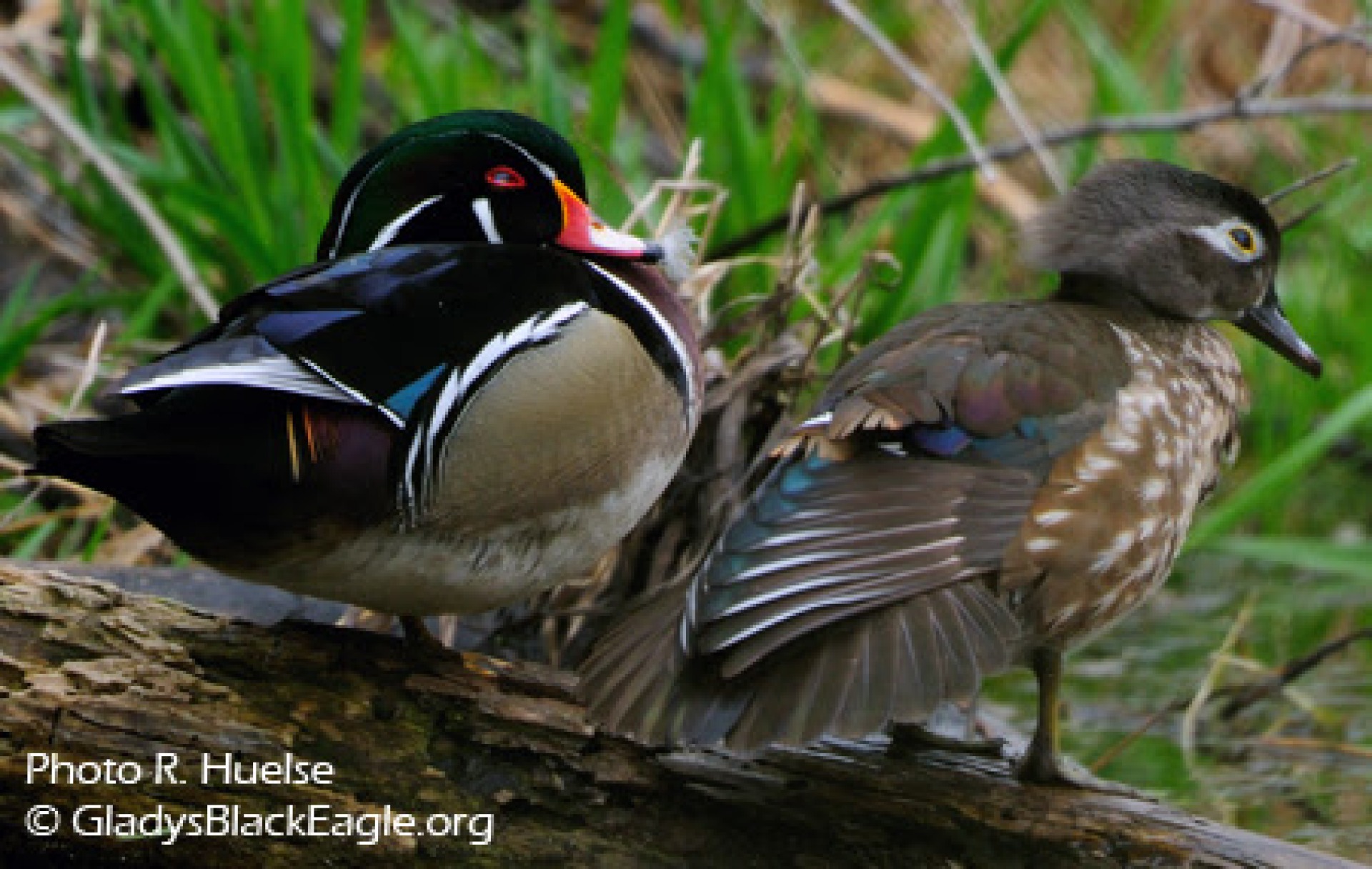Feathers... of course!
Marla Mertz, Marion County Conservation
There are so many subjects and fascinating nature tidbits, it seems impossible to run out of ideas to share about awareness, history, and knowledge. If I procrastinate long enough, a subject magically appears through conversation or observation.
Birds seem to be everywhere. Saying ‘hello’ again to our Midwest nesting birds is often the most exciting part of spring. These magnificent birds in their colorful, boastful breeding plumage has many of us glued to binoculars, eyes to the sky, and ears open to the distant sounds of the familiar and unfamiliar residents and visitors.
Birds in flight are truly mesmerizing to observe. Humans have been intrigued by their masterful grace since the beginning of time. Many of us gasp in awe and envy of their marvels. Birds can be found around us everywhere, worldwide. They are sometimes so common that we take them for granted.
The one thing that truly defines a bird as a bird...Feathers, of course!
Feathers come in all shapes, colors, and sizes, but can be classified into six different types of feathers based on function. When we first observe a bird, the feathers we see are the flight and contour feathers. The feathers that lie underneath the contour feathers and are closest to the body to regulate temperature are the down feathers. The other three types of feathers are very useful to birds, but are not as common. They are called semiplume, filoplume, and bristle feathers.
Flight feathers are found on the wings and the tail. They are usually long, and on the wings, there is usually one side of the vane that is much wider and longer than the other. Referred to as Pennae, the feathers are shaped like a Quill pen, having a flattened vane with many interlocking units growing out in one plane from a supporting central mid-rib (sometimes called rachis). Flight feathers help propel the bird through the air.
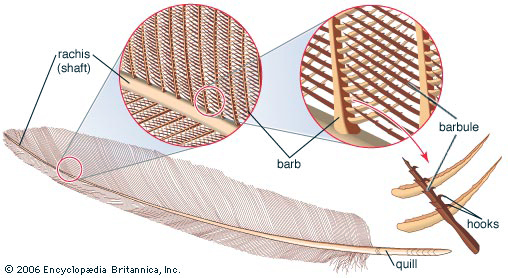
Alongside the rachis are several hundred filaments, or barbs, that run parallel, each of which has along its length several hundred pairs of interlocking barbules, zipping the barbs together. If we were to view a featherless body of a bird, you could see that feathers are grown from special papillae (small rounded projections on the body) that we sometimes call goose pimples or chicken skin. These papillae may produce one to three sets of feathers each year.
Contour feathers give shape and color to the bird. Contour feathers are colored only at the ends (the part we see) and are everywhere except the beak, legs, and feet. At the base of the contour feather it becomes downy which helps insulate the bird. They can be large feathers with asymmetrical vanes or smaller feathers and have symmetrical vanes.
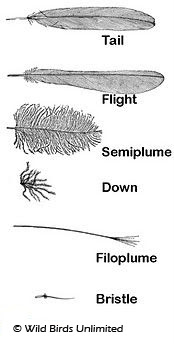
Down feathers are much simpler in design. The rachis is very short and there are no barbules. This is why the down is so fluffy. A very important function of these feathers is controlling a bird’s body temperature. Heat is retained by an insulating layer of air which is trapped close the skin by the feathers. Birds will puff up and fluff out their feathers when they are cold to increase the insulating layer.
Waterbirds, like herons have specialized down feathers called powder down which breaks up into a fine powder. The bird then spreads this fine powder all over its body to act as a water repellent.
Many bird hatchlings are covered in natal down. Natal down is a much simpler structure than the down of an adult bird.
Filoplume feathers are incredibly small, hair-like feathers and are considered a ‘sensory’ feather. They have a tuft of barbs at the end of the shaft. Unlike other feathers which are attached to muscle for movement, filoplume feathers are attached to nerve endings. The filoplume feathers send messages to the brain that give information about the placement of feathers for flight, insulation, and the need for preening. Filoplumes are most abundant at the base of the wing. Each flight feather may have 8-12 filoplumes.
Bristle feathers are very stiff with only a few barbs found at the base. Bristle feathers are found around the mouth of insect-catching birds where they act as a funnel. They can also be found around the eyes where they work like eyelashes. Woodpeckers, nighthawks, and other insect eaters have bristle feathers over their nostrils. Owls have long facial bristles. These feathers often go unseen unless we have the opportunity for close-up inspection.
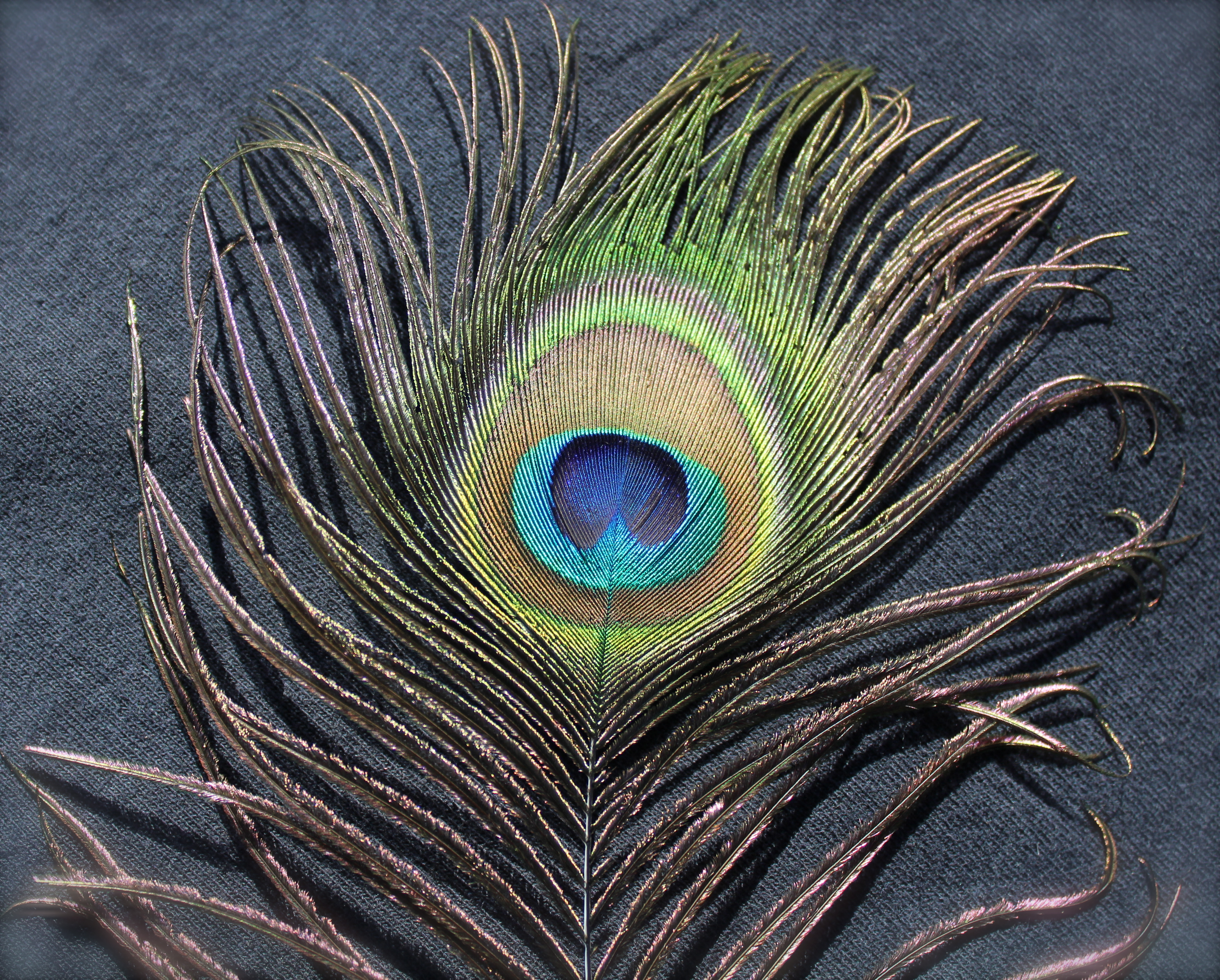
Feathers come in almost every color of the rainbow.
Do you know the colors of the rainbow? If I give you a clue, Roy G. Biv, would you remember? Red, orange, yellow, green, blue, indigo and violet are the hues that commonly describe the colors of a rainbow. In feathers, there is no blue pigment. So, how can a bluebird be blue? The answer is found in the structure of the feather and the way it is designed. When white light hits a blue feather, the feather is designed to reflect back only the blue light to our eyes. However, if you shine a white light from underneath the feather, the blue color disappears. There are 3 principal pigments in bird feathers. Melanin is the most common pigment and produces the black, grays, and browns. Carotenoid pigments produce intense reds and yellow and porphyrins produce a range of reds, browns, and greens. Structural colors are produced by the structure of the feather. Instead of pigments, these colors are produced as light is refracted by the proteins in the feather. Iridescent feathers glow and shimmer (peacock feathers) and non-iridescent feather structures scatter incoming light (indigo bunting, blue-jays, and bluebirds).
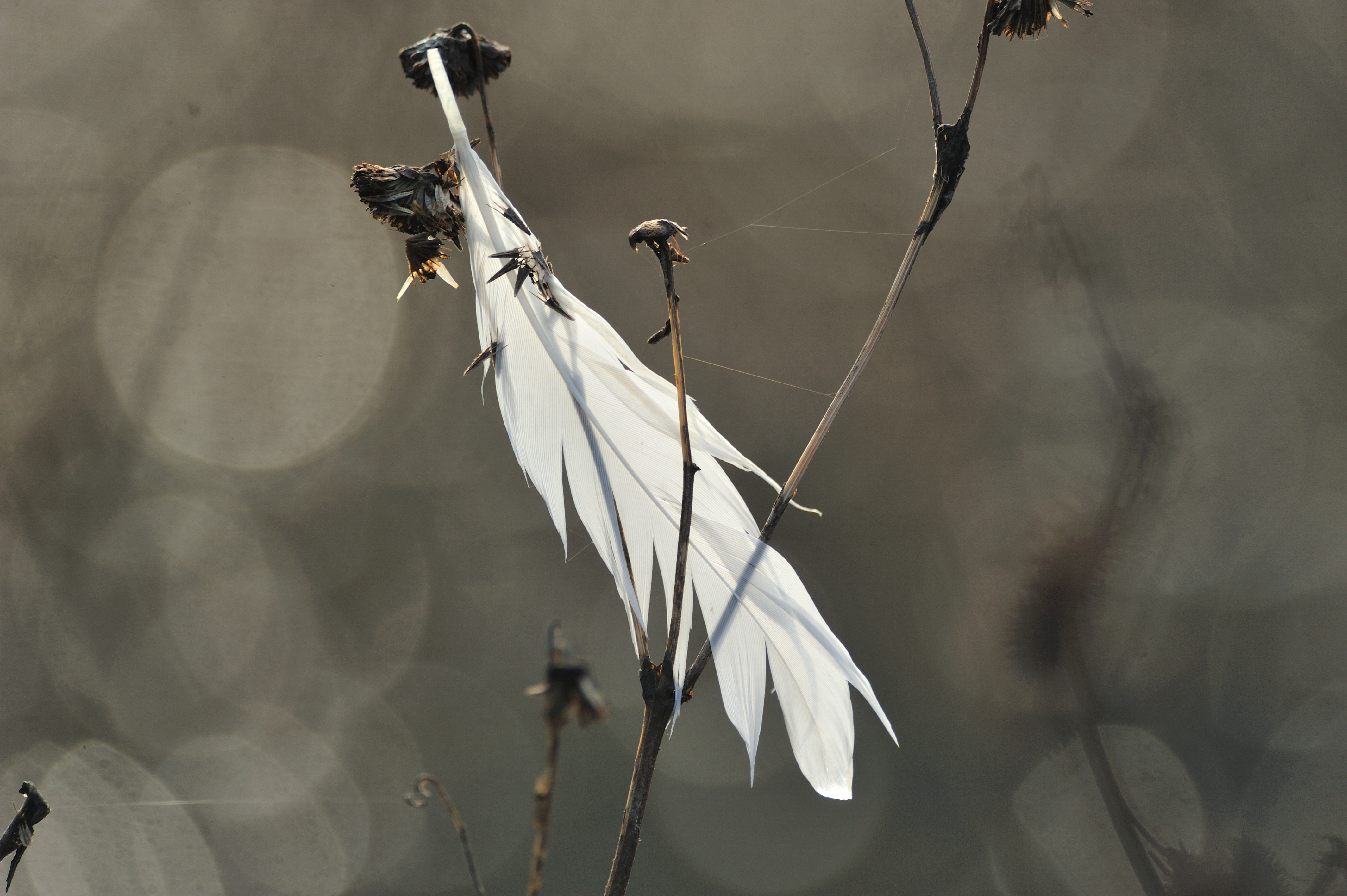
Why do birds molt?
Because of wear and tear, bathing, preening, fighting, and the effects of external parasites, feathers eventually become worn. The process where feathers are systematically replaced is called molting. Feathers normally need to be flight-worthy for about a year. Some birds spend up to 30 percent of their time preening or cleaning and oiling feathers. Most birds have an uropygial gland on their back just in front of the tail. The gland produces oil the bird squeezes out with its bill. Then the bird strokes its feathers with its partially closed bill to apply this waterproofing oil. Preening also helps strip parasitic feather mites.
Ducks, geese, and swans typically molt once a year after nesting season. Many waterfowl lose their feathers in June, July, or August. They are flightless for several weeks, which makes them vulnerable to predators. However, waterfowl nest in and around wetlands and can hide out from predators in the dense reeds and foliage of their habitat. New feathers grow in time for fall migration with the help of the protein and calorie-dense aquatic vegetation and small invertebrates they eat.
Most other birds cannot afford to lose their flight ability. They lose feathers a few at a time in a systematic progression of feather replacement.
Feathers perform four important functions.
Feathers form an insulating layer around the whole body: Feathers control a bird’s body temperature. Heat is retained by an insulating layer of air which is trapped close the skin by the feathers. Birds will puff up and fluff out their feathers when they are cold to increase the insulating layer.
Feathers create wing and tail surfaces essential for flight. Feathers give a bird’s body a streamlined shape and provide flight surfaces. Contour feathers are the main covering of the bird’s body and gives the streamlining effect. A bird may be able to alter the position of their contour feathers to give it more flight efficiency.
Waterproofed feathers keep the body dry. Feathers must function in temperature extremes from desert heat to icy tundra and weatherproofing maintains function. Waterproof feathers will not become covered with ice during subzero temperatures.

The colors and patterns provide a bird with camouflage, territory dominance, and mate selection. Camouflage is a function of feather covering. Most birds we see perched or flying above us appear lighter underneath than the coloration on the top. A bird’s countershading’ may help reduce detection by predators and prey. Countershading allows blending in with their background and gives a flatter appearance from below. Plumage patterns in many female species camouflages them with their environment during nesting season and appear inconspicuous when sitting on their nest. Can you think of a few examples of female birds that are camouflaged?
Spring plumage is bold, beautiful, and defining.
The colors and patterns are associated with breeding behavior and courtship ceremonies. Feather patterns are vital to species recognition. Breeding plumes, crests, vibrant color, feather patches, and other boastful changes are shown during courtship displays. This enables females of the specie to recognize the ‘right’ potential mate. Migratory songbirds and waterfowl are two groups of birds that plumage is in fine order upon spring return.
- Read Love is in the air! to learn about courtship.
How many feathers are on a bird?
The number of feathers on a bird varies according to the age, time of year, and specie. The larger the bird, the greater number of feathers. Adult bald eagles have approximately 7,000 feathers while a ruby-throated hummingbird has been recorded with about 940 feathers. The colder the climates, the more feathers a bird has in the winter. Some birds may have up to 30 percent more feathers during the winter than the summer.
Links for educators:
- Bird feathers from Kidwings
- Everything you need to know about feathers - There are 6 or more pages - each with a different topic about feathers!
- The Feather Atlas from USFWS - glossary, terms, photos, more
- What makes owls so quiet? A PBS video from their Deep Look series
Look at some amazing feathers in this album, opens in Google Photos.
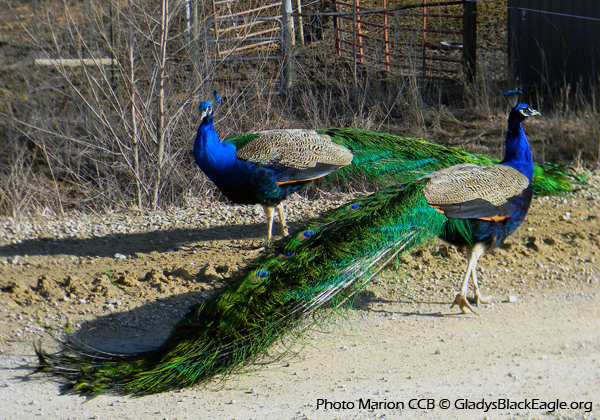
Celebrating 100 years of bird conservation.
In the early 1900s, birds were hunted for their feathers. The beautiful plumes and showy feathers were used to decorate women’s hats. Some species, like the snowy egret, had very low populations.
The U.S. Fish & Wildlife Service will celebrate in August 2016 the centennial of the signing of the foundational treaty that launched international conservation efforts for migratory birds. Two years later, the United States enacted the Migratory Bird Treaty Act.
Fortunately, the Migratory Bird Treaty Act of 1918 helped save many species of birds. The Migratory Bird Treaty Act is a commitment by four countries (United States, Russia, Japan, and Mexico) to protect birds that are regularly found in each country. This act made it illegal to collect or possess any bird, feather, egg, or nest.
Birds found in the United States that are not protected by any laws include the house or English sparrow, rock pigeon, and European starling. These three species were brought here from Europe and are not native to our country.
So if you find a beautiful feather laying on the ground what should you do? The best thing is to pick it up, study and enjoy it, and then put it back where you found it. The same thing goes for any abandoned eggs or nests you find. In order to keep any part of a bird, you need to have two special permits, one from the state where you are collecting birds and the other from the federal government.
References used:
- Birds in Flight, The Art and Science of How Birds Fly by Carrol L. Henderson
- Birds, Their Life, Their Ways, Their World Reader's Digest
published Saturday, April 1, 2023

